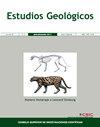Los micromamíferos (Lagomorpha, Eulipotyphla y Rodentia) del yacimiento del Pleistoceno Medio de Cuesta de la Bajada (Teruel, España): Estudio sistemático y consideraciones paleoambientales
IF 0.8
4区 地球科学
Q3 GEOLOGY
引用次数: 8
Abstract
The micromammal association established in this work is the following: Lagomorpha: Oryctolagus cuniculus; Eulipotyphla: Crocidura cf. russula, cf. Sorex sp., Neomys sp., Soricidae indet. and Talpa sp.; and Rodentia: Eliomys quercinus, Apodemus cf. sylvaticus, Cricetulus (Allocricetus) bursae, Arvicola aff. sapidus, Microtus (Iberomys) brecciensis and Microtus (Terricola) duodecimcostatus. This association is characteristic of the Middle Pleistocene. The morphological state of Cricetulus (A.) bursae, Arvicola aff. sapidus and Microtus (I.) brecciensis allows to place it in the advanced, but not final, Middle Pleistocene, which agrees with the numerical data of the site (243–337 ka) that places it in the MIS 8 or 9. The micromammals indicate the predominance of the open spaces with abundant vegetation mainly of herbaceous and bushes but also with some areas with trees. The climate would be of Mediterranean type, similar to the actual or perhaps a little milder and more humid.西班牙特鲁埃尔Cuesta de la Bajada中更新世遗址的微哺乳动物(Lagomorpha, Eulipotyphla和Rodentia):系统研究和古环境考虑
本研究建立的微哺乳动物分类如下:Lagomorpha; Oryctolagus cuniculus;真丝蝗科:棘蝗科,棘蝗科,棘蝗科,棘蝗科。和塔尔帕;啮齿类:槲皮鼠、森林田鼠、法氏囊环鼠、长尾环鼠、长尾环鼠、角尾环鼠和十二指肠环鼠。这种组合是中更新世的特征。cretulus (A.) bursae、Arvicola af . sapidus和Microtus (I.) brecciensis的形态状态使其处于中更新世晚期,而不是晚期,这与该遗址(243-337 ka)的数值数据一致,将其置于MIS 8或MIS 9。小型哺乳动物以草本植物和灌木植被丰富的开放空间为主,但也有部分地区有树木。气候将是地中海式的,类似于实际的气候,或者可能更温和,更潮湿。
本文章由计算机程序翻译,如有差异,请以英文原文为准。
求助全文
约1分钟内获得全文
求助全文
来源期刊

Estudios Geologicos-Madrid
GEOLOGY-
CiteScore
1.40
自引率
14.30%
发文量
6
审稿时长
>12 weeks
期刊介绍:
Since 1945 Estudios Geologicos publishes original research works, as well as reviews, about any topic on Earth Sciences.
Estudios Geologicos is published as one yearly volume, divided into two half-yearly issues. It is edited by the Spanish National Research Council (Consejo Superior de Investigaciones Científicas, CSIC) at the Instituto de Geociencias (CSIC-UCM).
Estudios Geologicos provides free access to full-text articles through this electronic edition. Accepted articles appear online as "Forthcoming articles" as soon as the galley proofs have been approved by the authors and the Editor-in-Chief. No changes can be made after online publication.
 求助内容:
求助内容: 应助结果提醒方式:
应助结果提醒方式:


